Before closing the doors at a Levi Strauss & Co. retail store on the East Coast, staff contacted me with an urgent request. They were nearly finished packing and cleaning for a move but were stumped by an oversize item in an awkward location.
Wedged between brick and stone walls was a sculpture — two large matching sculptures actually — both clad in copper. But that wasn’t all. Metal rods attached to the copper sculptures connected to a single pair of copper-riveted denim pants: 501® jeans.
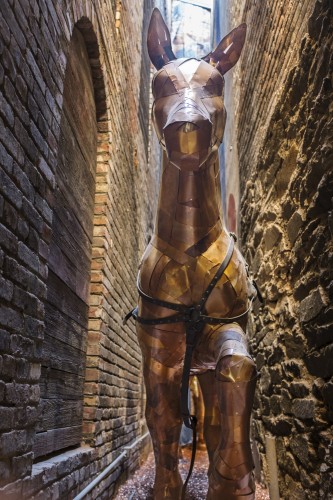
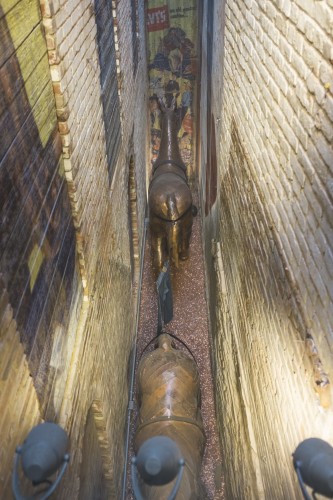
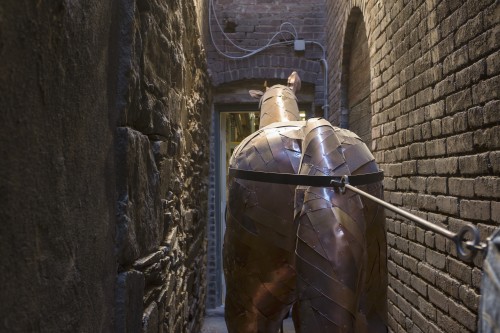
I asked for photos and got to work making inquiries. One thing I knew for certain — the sculpture was an artistic version of LS&Co.’s famous Two Horse Design, introduced exactly 130 years ago.
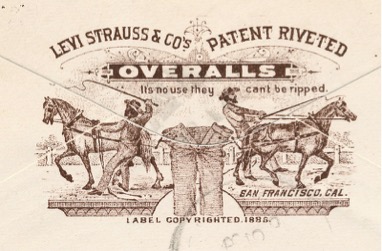
A Distinctive Design
In 1873, Levi Strauss and Jacob Davis patented the design for riveted pants and for nearly 20 years enjoyed legal protection from competitors while manufacturing the world’s first blue jeans. LS&Co. carefully considered an innovative method for differentiating their garments as the patent expiration neared. How could they demonstrate the strength and quality of their rugged work pants? Could they incorporate something distinctive into LS&Co. garments that would endure the test of time? If so, what possible symbol would customers, even those who couldn’t read, recognize?
The solution came in 1886. A unique graphic would be applied to the leather patch above the back right pocket of the riveted pants. LS&Co. trademarked the design, which could be applied to other parts of the pant — like the inside pocket bag — and then expanded to other garments and prints.
The design? A pair of Levi Strauss & Co. waist overalls, the original name for 501® jeans, attached to two horses attempting to pull them apart. “It’s no use they can’t be ripped,” the early trademark read. Simple and easy to understand, the design visually reinforced of the quality of the pants while being distinctive and unique.
Vintage Versions of the Two Horse Design
Proof that the design has withstood the test of time lies in the LS&Co. Archives, where several early garment examples with the Two Horse Pull are preserved. On the pocket bag of the Calico Jeans (1890), the design appears above the following text:
For Over 17 Years
Our celebrated XX Blue Denim Copper
Riveted Overalls have been before the public
THIS IS A PAIR OF THEM!
It’s the “17 Years” that spurred Barbara Hunter, who found the jeans in the 1940s, to write a letter to LS&Co. in San Francisco about her discovery.
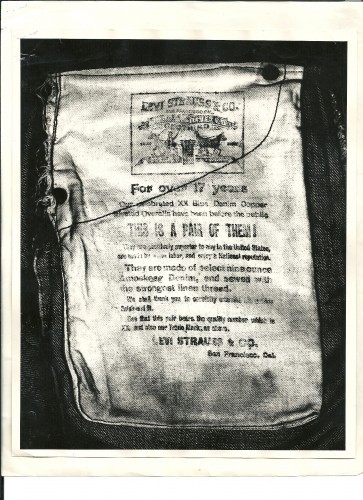
Calico Pocket Back with Two Horse Design (1890).
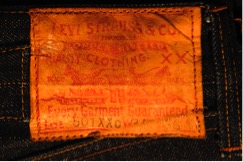
Leather Patch with Two Horse design on a vintage 501® jeans.
Two Horse Design Spin-offs
The distinctive Two Horse Design inspired other businesses to create similar marks. Instead of horses, Carson Glove on nearby Market Street in San Francisco selected dogs to demonstrate the strength of their products in 1901.
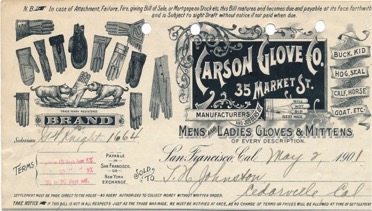
Courtesy of Dr. Robert Chandler
Dogs and horses might seem a trifle lightweight when compared with the elephants Boss Union Made used on their trademark.
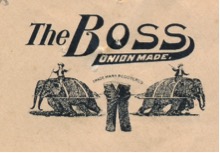
Courtesy of Dr. Robert Chandler
World’s Fifth Oldest Trademark
Since its creation, the Two Horse Design has been used continuously on 501® jeans, and was later incorporated into other Levi’s® garments and materials. This longtime use was recognized in 2014 by 24/7 Wall Street, which named the Two Horse Design the fifth oldest continuously used trademark in the world.
At 130 years old, the Two Horse Design is still going strong, appearing on patches on our latest 501® jeans, the new women’s denim collection and other additions like our Wedgie jean.
Enduring Art of the Two Horse Design
The striking copper sculpture is in a historic neighborhood where two buildings abut one another. An imaginative designer saw the space as the perfect spot for a unique installation. Along with the horses, early LS&Co. advertisements were added to the space, one painted on the brick wall just like early company “billboards.”
The downside of the close-fitting quarters is that the sculpture is nearly impossible to move without “monumental” effort. So the horses will remain there as a reminder of the enduring legacy and strength of the Levi Strauss & Co. brand and the toughness of its jeans.
ABOUT THE AUTHOR
 Tracey Panek is the Historian for Levi Strauss & Co. where she manages the day-to-day workings of the Levi Strauss & Co. Archives as a key corporate asset, answering historical questions, assisting designers, brand managers, executives and other employees whose work requires historical materials in the Archives.
Tracey Panek is the Historian for Levi Strauss & Co. where she manages the day-to-day workings of the Levi Strauss & Co. Archives as a key corporate asset, answering historical questions, assisting designers, brand managers, executives and other employees whose work requires historical materials in the Archives.
Prior to joining LS&Co., Tracey spent 14 years as Historian and Archivist at AAA Northern California, Nevada & Utah where she managed a corporate history program for the 100+ year old company. She began her corporate history career at AirTouch Communications—today Verizon and Vodafone—a San Francisco based company that launched cellular service at the Los Angeles Olympics in 1984.
Like this story?
Sign up for the Unzipped newsletter to get the best of the Unzipped blog — company news and views, employee profiles, innovation and sustainability stories, behind-the-scenes and Archives highlights — sent straight to your inbox weekly.







